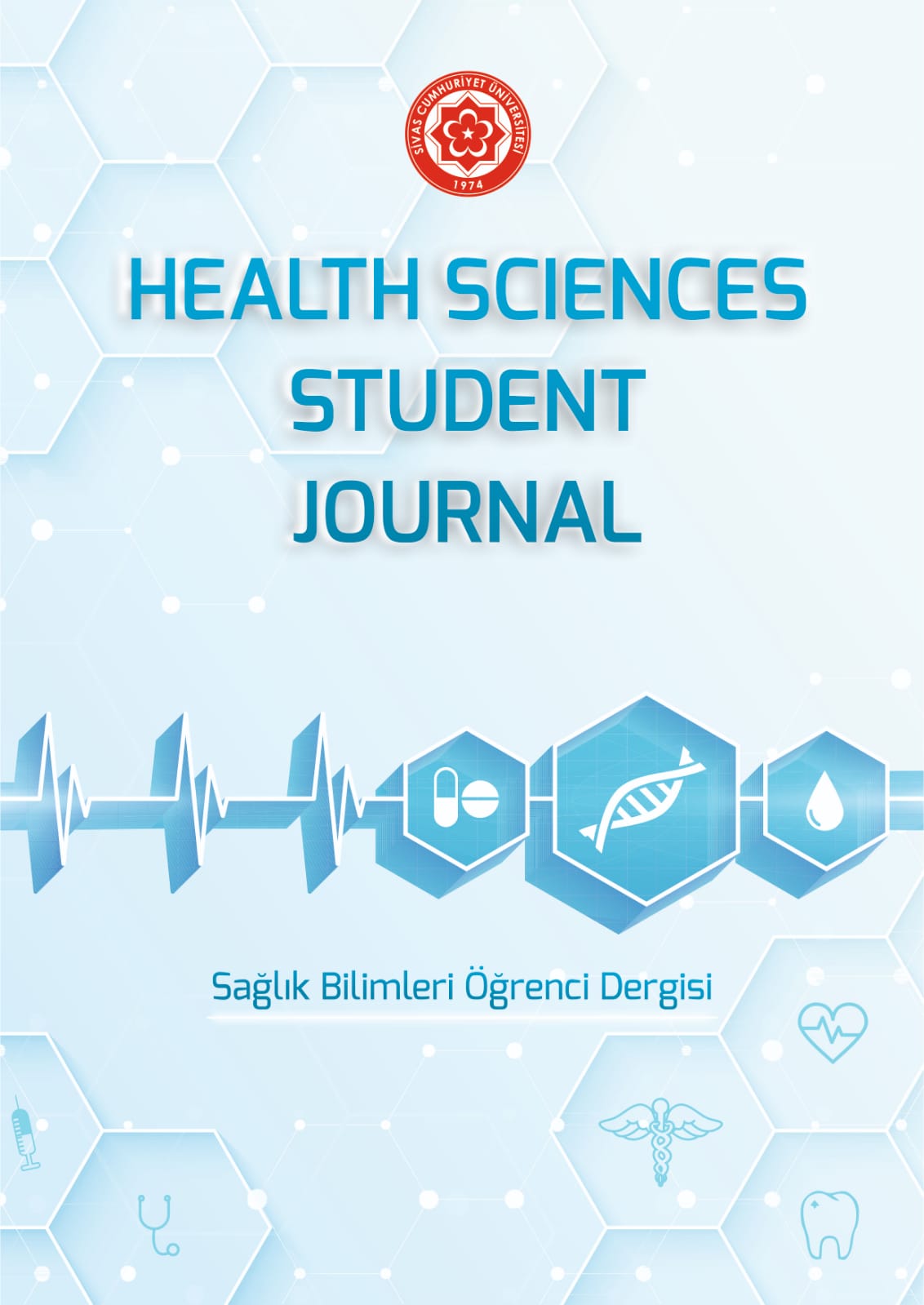![]()
Investigation of the effect of fluconazole on SH-SY5Y Neuroblastoma and MCF-7 Breast Adenocarcinoma cells
Yazarlar: Talha ÖZSARI1, Fatih YULAK2,3, Bilal ŞAHİN2
Corresponding author
1Talha Özsarı, Sivas Cumhuriyet Üniversitesi Tıp Fakültesi Dönem 2, Sivas, Türkiye
E-mail: talhaozsari@gmail.com
Other authors
2Sivas Cumhuriyet Üniversitesi Tıp Fakültesi Fizyoloji Anabilim Dalı, Sivas, Türkiye
3Sivas Cumhuriyet Üniversitesi Tıp Fakültesi Araştırma Merkezi (CÜTFAM)
ÖZET
Amaç: Azol türevi bileşikler son zamanlarda antikanser etkileriyle ön plana çıkmaktadır. Bizim de amacımız bir azol türevi olan flukonazolün antikanser etkisini SH-SY5Y nöroblastom ve MCF-7 Meme adenokarsinom hücreleri üzerinde araştırmaktır.
Yöntem: SH-SY5Y ve MCF-7 hücre kültüründe kontrol grubu ve ilaç grubu olmak üzere 2 grup planlanmıştır. Kontrol grubuna herhangi bir uygulama yapılmazken ilaç grubuna çeşitli konsantrasyonlarda (1.56; 3.125; 6.25; 12.5 ve 25 μM) flukonazol 24 saat boyunca uygulanmıştır. XTT hücre canlılığı testi ile flukonazolün hücre proliferasyonu üzerine etkisi belirlenmiştir.
Bulgular: Elde edilen veriler, çalıştığımız dozlardaki flukonazolün, SH-SY5Y nöroblastom ve MCF-7 meme adenokarsinom hücreleri üzerine hücre canlılığı açısından istatistiksel olarak anlamlı bir etkisi bulunmamıştır (p>0.05).
Sonuçlar: : XTT hücre canlılığı sonuçları değerlendirildiğinde, flukonazolün SH-SY5Y nöroblastom ve MCF-7 meme adenokarsinom hücrelerinin hücre canlılığı üzerine etkisi gözlenmemiştir. Bu etkisizlik durumu uygulanan flukonazol dozu ile ilişkilendirilebilir.
Anahtar Kelimeler: Flukonazol, hücre canlılığı, kanser, MCF-7 meme adenokarsinom, SH-SY5Y nöroblastom.
ABSTRACT
Objective: Azole derivatives have recently come to the fore with their anticancer effects. Our aim is to investigate the anticancer effect of fluconazole, an azole derivative, on SH-SY5Y neuroblastoma and MCF-7 breast adenocarcinoma cells.
Method: In SH-SY5Y and MCF-7 cell culture, 2 groups were planned as the control group and the drug group. While no application was made to the control group, various concentrations of fluconazole (1.56; 3.125; 6.25; 12.5 and 25 μM) were administered to the drug group for 24 hours. The effect of fluconazole on cell proliferation was determined by the XTT cell viability test.
Results: The obtained data showed that no statistically significant difference was found in terms of cell viability of fluconazole at the doses we studied on SH-SY5Y neuroblastoma and MCF-7 breast adenocarcinoma cells (p>0.05).
Conclusions: When the XTT cell viability results were evaluated, no effect of fluconazole on the cell viability of SH-SY5Y neuroblastoma and MCF-7 breast adenocarcinoma cells was observed. This ineffectiveness may be related to the dose of fluconazole administered.
Keywords: Cancer, cell viability, fluconazole, MCF-7 breast adenocarcinoma, SH-SY5Y neuroblastom.
How to Cite (APA 7)
Ozsari, T., Yulak, F., Sahin, B. (2021). Flukonazol’un SH-SY5Y Noroblastom ve MCF-7 Meme Adenokarsinom Hucreleri Uzerine Etkisinin Arastirilmasi. Health Sciences Student Journal, 1(2), 35-39. https://healthssj.com/flukonazolun-sh-sy5y-noroblastom-ve-mcf-7-meme-adenokarsinom-hucreleri-uzerine-etkisinin-arastirilmasi
KAYNAKÇA/REFERENCES
1. Cooper GM. The Cell : A Molecular Approach /. ASM Press ; 2004.
2. Genetik Kavramlar – 11. Baskı (Klug-Cummings) — E-kitap — Turcademy. Accessed May 3, 2021. https://www.turcademy.com/tr/kitap/genetik-kavramlar-11-baski-klug-cummings-9786053558811
3. IARC Publications Website – World Cancer Report 2008. Accessed May 3, 2021. https://publications.iarc.fr/Non-Series-Publications/World-Cancer-Reports/World-Cancer-Report-2008
4. Jemal A, Bray F, Center MM, Ferlay J, Ward E, Forman D. Global cancer statistics. CA Cancer J Clin. 2011;61(2):69-90. doi: 10.3322/caac.20107
5. Vet Y, Derg F. Apoptozis. Vol 19.; 2008. Accessed May 3, 2021. https://dergipark.org.tr/tr/pub/yyuvfd/166307
6. Whittle SB, Smith V, Doherty E, Zhao S, McCarty S, Zage PE. Overview and recent advances in the treatment of neuroblastoma. Expert Rev Anticancer Ther. 2017;17(4):369-386. doi: 10.1080/14737140.2017.1285230
7. FERLAY, J. GLOBOCAN 2008 v1.2, Cancer incidence and mortality world-wide : IARC Cancer Base No. 10. http://globocan.iarc. Published online 2010.
8. Steeg PS. Tumor metastasis: Mechanistic insights and clinical challenges. Nat Med. 2006;12(8):895-904. doi: 10.1038/nm1469
9. Manual of clinical microbiology (Book, 2007) [WorldCat.org]. Accessed May 3, 2021. https://www.worldcat.org/title/manual-of-clinical-microbiology/oclc/63195972
10. Medical Microbiology – 8th Edition. Accessed May 3, 2021. https://www.elsevier.com/books/medical-microbiology/murray/978-0-323-29956-5
11. S K. Clotrimazole as a Cancer Drug:A Short Review. Med Chem (Los Angeles). 2014;4(11):722-724. doi: 10.4172/2161-0444.1000219
12. Bae SH, Park JH, Choi HG, Kim H, Kim SH. Imidazole antifungal drugs inhibit the cell proliferation and invasion of human breast cancer cells. Biomol Ther. 2018;26(5):494-502. doi: 10.4062/biomolther.2018.042
13. Ho YS, Tsai PW, Yu CF, Liu HL, Chen RJ, Lin JK. Ketoconazole-induced apoptosis through P53-dependent pathway in human colorectal and hepatocellular carcinoma cell lines. Toxicol Appl Pharmacol. 1998;153(1):39-47. doi: 10.1006/taap.1998.8467
14. Bockstaele L, Coulonval K, Kooken H, Paternot S, Roger PP. Regulation of CDK4. Cell Div. 2006;1:1-16. doi: 10.1186/1747-1028-1-25
15. Shim JS, Liu JO. Recent advances in drug repositioning for the discovery of new anticancer drugs. Int J Biol Sci. 2014;10(7):654-663. doi: 10.7150/ijbs.9224
16. Tsubamoto H, Ueda T, Inoue K, Sakata K, Shibahara H, Sonoda T. Repurposing itraconazole as an anticancer agent (Review). Oncol Lett. 2017;14(2):1240-1246. doi: 10.3892/ol.2017.6325
17. Essentials of Medical Pharmacology – KD Tripathi – Google Kitaplar. Accessed May 3, 2021. https://books.google.com.tr/books?hl=tr&lr=&id=FfG8AQAAQBAJ&oi=fnd&pg=PR1&ots=OFsGCi350t&sig=R715UDdXCodMsGeQCMo6LQl0wio&redir_esc=y#v=onepage&q&f=false
18. S K. Clotrimazole as a Cancer Drug:A Short Review. Med Chem (Los Angeles). 2014;4(11). doi: 10.4172/2161-0444.1000219
19. Taplin ME, Regan MM, Ko YJ, et al. Phase II study of androgen synthesis inhibition with ketoconazole, hydrocortisone, and dutasteride in asymptomatic castration-resistant prostate cancer. Clin Cancer Res. 2009;15(22):7099-7105. doi: 10.1158/1078-0432.CCR-09-1722
20. Vasaitis TS, Bruno RD, Njar VCO. CYP17 inhibitors for prostate cancer therapy. J Steroid Biochem Mol Biol. 2011;125(1-2):23-31. doi: 10.1016/j.jsbmb.2010.11.005
21. Aftab BT, Dobromilskaya I, Liu JO, Rudin CM. Itraconazole inhibits angiogenesis and tumor growth in non-small cell lung cancer. Cancer Res. 2011;71(21):6764-6772. doi: 10.1158/0008-5472.CAN-11-0691
22. Antonarakis ES, Heath EI, Smith DC, et al. Repurposing Itraconazole as a Treatment for Advanced Prostate Cancer: A Noncomparative Randomized Phase II Trial in Men With Metastatic Castration‐Resistant Prostate Cancer. Oncologist. 2013;18(2):163-173. doi: 10.1634/theoncologist.2012-314
